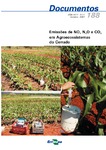Use este identificador para citar ou linkar para este item:
http://www.infoteca.cnptia.embrapa.br/infoteca/handle/doc/572290Registro completo de metadados
| Campo DC | Valor | Idioma |
|---|---|---|
| dc.contributor.author | CARVALHO, A. M. de | pt_BR |
| dc.contributor.author | BUSTAMANTE, M. M. da C. | pt_BR |
| dc.date.accessioned | 2011-07-08T11:54:51Z | - |
| dc.date.available | 2011-07-08T11:54:51Z | - |
| dc.date.created | 2008-04-24 | pt_BR |
| dc.date.issued | 2007 | pt_BR |
| dc.identifier.citation | Planaltina, DF: Embrapa Cerrados, 2007. | pt_BR |
| dc.identifier.uri | http://www.infoteca.cnptia.embrapa.br/infoteca/handle/doc/572290 | pt_BR |
| dc.description | ABSTRACT: In the last 30 years, the Cerrado Biome has suffered very intense conversion of its native vegetation into croplands (Brazilian Savanna). This habitat modification has contributed with 25% and 90% of the total CO2 and N2O anthropogenic emission respectively. Soil preparation (tillage and no-tillage), deposition of crop residues, cultivation of N-fixing species and nitrogen fertilization are management practices that influence trace gas fluxes from soil to atmosphere. Nevertheless, the interaction between such practices and NO, N2O and CO2 fluxes in the Cerrado region is still unclear. Raining events after the dry season results in NO and CO2 pulses. The interaction between nitrogen application-during rain events affects NO and CO2 emissions. The soil in the no-tillage system when under leguminosae shows higher annual emissions of CO2. In the seasonal dry, most of the N2O fluxes values are below the detection limit. Higher NO fluxes are found immediately (5.4 ng NO-N cm-2 h-1) and 3 days (4,8 ng NO-N cm-2 h-1) after N fertilization and irrigation. After the first pulses of NO (5,4 ng NO-N cm-2 H-1 and 4,8 ng NO-N cm-2 h-1), the emission decreases significantly (1.9 ng NO-N cm-2 h-1). Residues of cover plants and nitrogen fertilization associated to raining events affects trace gas fluxes. | pt_BR |
| dc.language.iso | por | pt_BR |
| dc.relation.ispartofseries | (Embrapa Cerrados. Documentos, 188). | pt_BR |
| dc.rights | openAccess | pt_BR |
| dc.title | Emissões de NO, N2O e CO2 em agroecossistemas do Cerrado. | pt_BR |
| dc.type | Folhetos | pt_BR |
| dc.date.updated | 2011-07-08T11:54:51Z | pt_BR |
| dc.subject.thesagro | Carbono | pt_BR |
| dc.subject.thesagro | Conservação do Solo | pt_BR |
| dc.subject.thesagro | Efeito Estufa | pt_BR |
| dc.subject.thesagro | Gás | pt_BR |
| dc.subject.thesagro | Matéria Orgânica | pt_BR |
| dc.subject.thesagro | Manejo do Solo | pt_BR |
| dc.subject.nalthesaurus | greenhouse effect | pt_BR |
| dc.subject.nalthesaurus | gases | pt_BR |
| dc.subject.nalthesaurus | carbon | pt_BR |
| dc.subject.nalthesaurus | organic matter | pt_BR |
| dc.subject.nalthesaurus | soil management | pt_BR |
| dc.subject.nalthesaurus | soil conservation | pt_BR |
| dc.format.extent2 | 26 p. | pt_BR |
| riaa.ainfo.id | 572290 | pt_BR |
| riaa.ainfo.lastupdate | 2009-10-20 | pt_BR |
| dc.contributor.institution | Arminda Moreira de Carvalho, CPAC; Mercedes Maria da Cunha Bustamante, UnB. | pt_BR |
| Aparece nas coleções: | Série Documentos (CPAC)  | |
Arquivos associados a este item:
| Arquivo | Descrição | Tamanho | Formato | |
|---|---|---|---|---|
| doc188.pdf | 4,98 MB | Adobe PDF |  Visualizar/Abrir |









